Fixing upward curling of cannabis leaves
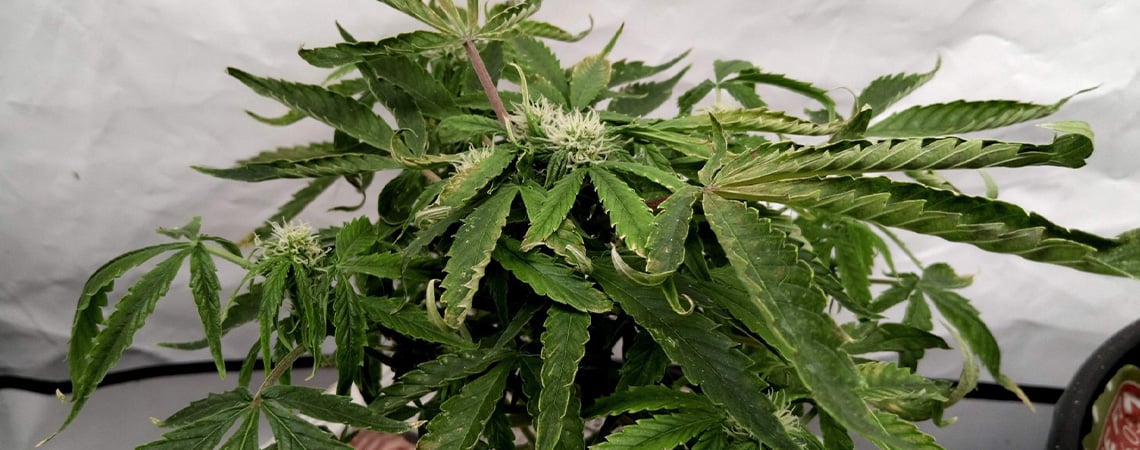
If your cannabis leaves are curling upward, your plants are trying to tell you something. Learn what’s causing it and how to restore balance fast with our extensive guide, packed with top tips and quick fixes. Read on to find out more.
Noticed your cannabis leaves curling up like tiny tacos? Don't panic! This is one of the most common signs that your plant is under stress, and in most cases, it's completely fixable. When cannabis leaf clawing occurs, your plant is trying to tell you something about its environment; whether that's too much light, heat, nutrients, or even the wrong humidity levels.
Understanding the cause behind cannabis leaves clawing is the first step to bringing your grow back to balance. In this guide, we'll break down how to identify cannabis curling, what each type of curl means, and the quick, practical steps you can take to fix it. You'll also find plenty of visual cues and links to detailed guides for each issue, so you can diagnose and correct the problem before it affects your yield.
What does upward curling look like?
When cannabis leaves are curling up, the change is usually distinct and hard to miss, but there are a few specific patterns and areas to watch for that signal that your cannabis leaves are clawing upward. Below is a breakdown of the visual clues you can use to confirm what you're dealing with.
Visual symptoms to spot

- Tacoing / canoeing: The leaflets (fingers) curl upward, often forming a trough-like shape like a taco or canoe. This is one of the most typical appearances of upward curling.
- Tips curling: Sometimes only the leaf tips or edges curl upward while the rest of the leaf remains relatively flat.
- Edges curling or clawing: The margins or sides of the leaves may bend upward more sharply, giving a claw-like impression.
- • Leaf surface cupping: The leaf surface might appear slightly concave, curving inward from the sides toward the middle.
- Uniform vs isolated: You might see one or two leaves doing this, or many, if many, it suggests a systemic issue.
Common zones for upward curling
- Upper leaves / newer growth: The leaves closest to the light or the top of the plant are often the first to show upward curling, since they receive the most direct exposure to light and heat.
- Near light fixtures or lamps: Leaves directly under or near intense light sources tend to react more strongly.
- Edges of the canopy: The outermost leaves (those closest to environmental boundaries) may also show early signs.
In short, if you see cannabis leaf clawing or leaves that curl upward, look for that signature canoeing, tip curling or raised edges, particularly on top leaves and those near your grow lights.
Quick diagnostic table
If your cannabis leaves are curling up, use this quick reference to match what you see with the most likely cause, and take immediate corrective action.
| Symptom | Likely cause | Immediate action |
| Top leaves curling up like tacos (“canoeing”) | Light stress or heat burn | Raise or dim grow lights, and improve air circulation. |
| Leaves feel dry and edges crisp | Low humidity / High VPD | Increase humidity to around 50–60%, and stabilise temperature. |
| Dark green, shiny leaves curling upward or clawing | Nitrogen toxicity or nutrient imbalance | Flush with pH-balanced water, reduce nutrient strength, and check pH levels. |
| Lower leaves curling up, the plant looks droopy | Overwatering or root stress | Allow soil to dry between waterings, improve drainage, and inspect root health. |
| Leaves twisting, discoloured, or showing bite marks | Environmental stress or pest damage | Check for pests and adjust fans or temperature extremes as needed. |
Top tip: If your cannabis leaf curling or clawing doesn’t perfectly match any single case, compare multiple symptoms, as plants often experience overlapping stresses at once.
Most common causes of upward curling
When your cannabis leaves are curling up or taking on that claw-like shape, it's a clear sign your plants are reacting to stress. The challenge is figuring out which kind. Below you'll find the leading causes of upward curling cannabis leaves, how to recognize each one and quick fixes you can apply immediately.
Light stress / heat burn

If your plant's upper leaves are curling upward, especially those nearest your grow light, excess heat or light intensity is likely to be the cause. This type of cannabis leaf curling usually appears alongside yellowing tips or slight bleaching near the top of the canopy.
Leaves react this way to protect themselves from overexposure, similar to how we'd squint in bright sunlight. Raising your lights just a few inches or lowering their intensity can make an immediate difference. It also helps to increase air circulation around the canopy to keep heat from building up.
For a deeper look at how lighting affects plant health, check out LED vs HPS article, and explore the seven common causes of plant stress that can lead to clawing or curling leaves.
Low humidity or high VPD

When the air around your plants is too dry, leaves often curl upward at the edges to conserve moisture. You might notice a papery texture or crispy margins, which are both signs of low humidity and high vapor pressure deficit (VPD).
In this environment, plants lose water faster than their roots can replace it, leading to cannabis leaves clawing upward as a defense mechanism. The fix is simple: increase humidity to around 50–60% and keep the temperature stable. Small changes can dramatically improve leaf health.
For detailed guidance on managing relative humidity and VPD balance, see our article on humidity and cannabis.
Nutrient imbalances (NPK / pH issues)
.jpg)
One of the most recognizable causes of cannabis leaf clawing is an excess of nitrogen or other nutrients. When this happens, leaves turn a dark, glossy green and curl or claw upward. You might also see burnt tips or slow, stiff growth.
The problem isn't always overfeeding; it can also be a pH imbalance that prevents your plant from properly absorbing nutrients. The best approach is to flush your medium with pH-balanced water, ease off nutrient strength and monitor your feeding schedule closely.
For a complete guide on how to spot and correct these issues, check out our nutrient deficiencies article.
Overwatering and root stress
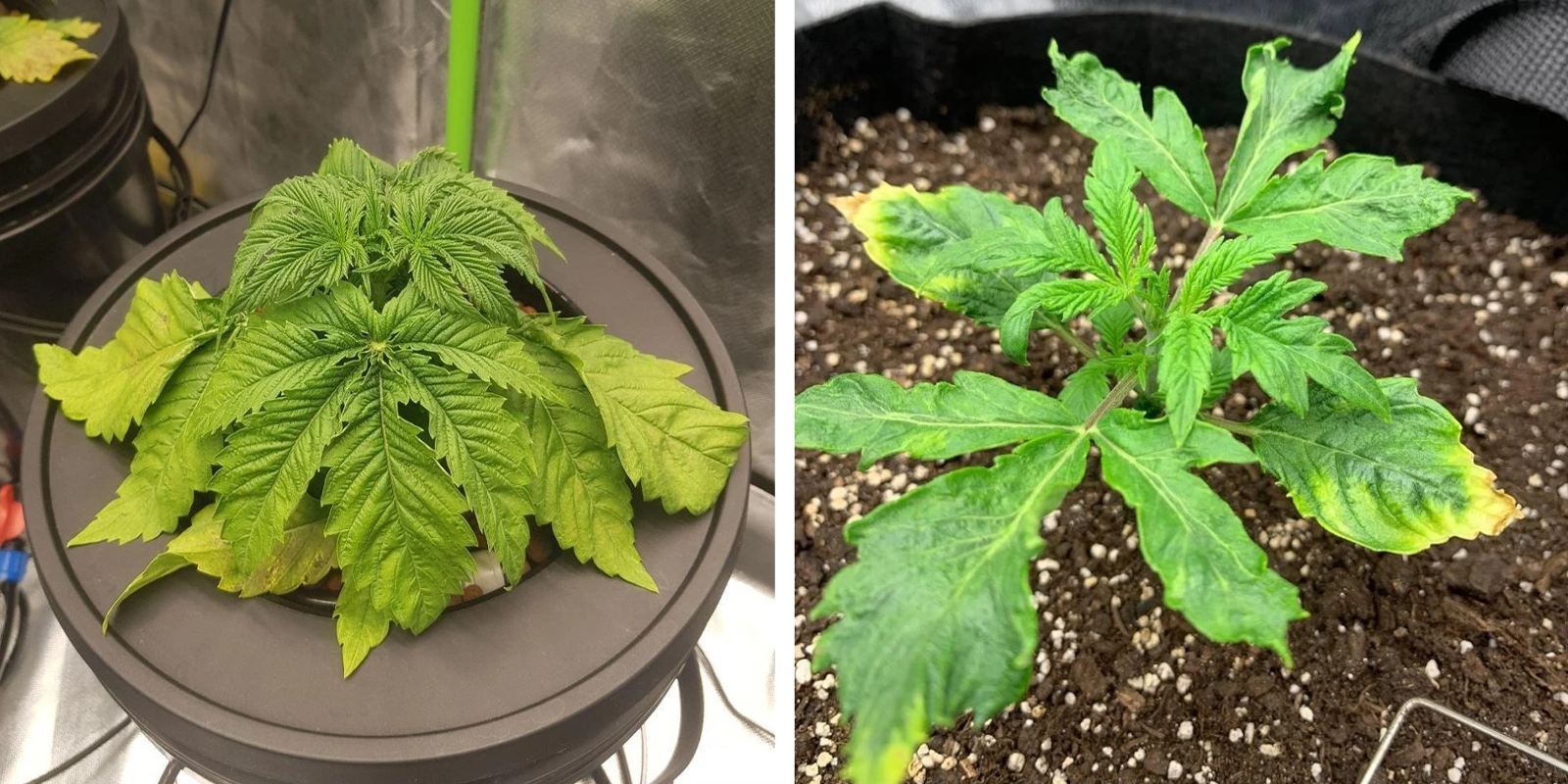
If you notice the lower leaves of your plant curling up while the rest appear droopy or heavy, overwatering could be the culprit. Roots need oxygen as much as they need water, and when the medium stays too wet for too long, they begin to suffocate.
This root stress quickly shows in the foliage: Leaves lose turgidity, curl upward, and growth slows down. Letting the medium dry out between waterings and improving drainage usually resolves the problem within a few days.
For practical watering advice, see how much water cannabis plants need.
Environmental stress or pests

Sometimes, clawing cannabis leaves isn't caused by light or nutrients, but by external stressors such as wind burn, cold drafts or pest infestations. Leaves may twist, discolor or show small bite marks, especially if spider mites or thrips are involved.
Inspect the undersides of leaves carefully with a magnifying glass and ensure your fans aren't blowing directly onto plants. Consistent environmental control and regular pest checks can prevent further damage.
If you suspect insects are to blame, our guide to common cannabis insect pests can help you identify and eliminate them before they spread.
What to do next: Step-by-step fix plan
If your cannabis leaves are curling up, don't rush to make every adjustment at once. The key is to stay methodical. This simple plan will help you identify what's wrong, take immediate action, and restore your plants to a healthy, balanced state.
1. Check your environment

Begin by checking the basics: light, temperature and humidity. These three factors are the most common triggers behind leaves curling up. If your grow lights feel hot at the canopy level, they're probably too close. Temperatures above 82°F or humidity below 40% can quickly lead to clawing leaves as plants try to protect themselves from stress.
Use a reliable thermometer and hygrometer to get accurate readings. Adjust your setup until conditions fall within healthy ranges; around 75–82°F during the day and 50–60% relative humidity during veg. You can explore more detailed advice on balancing your grow space in our complete growing guide.
2. Observe the whole plant
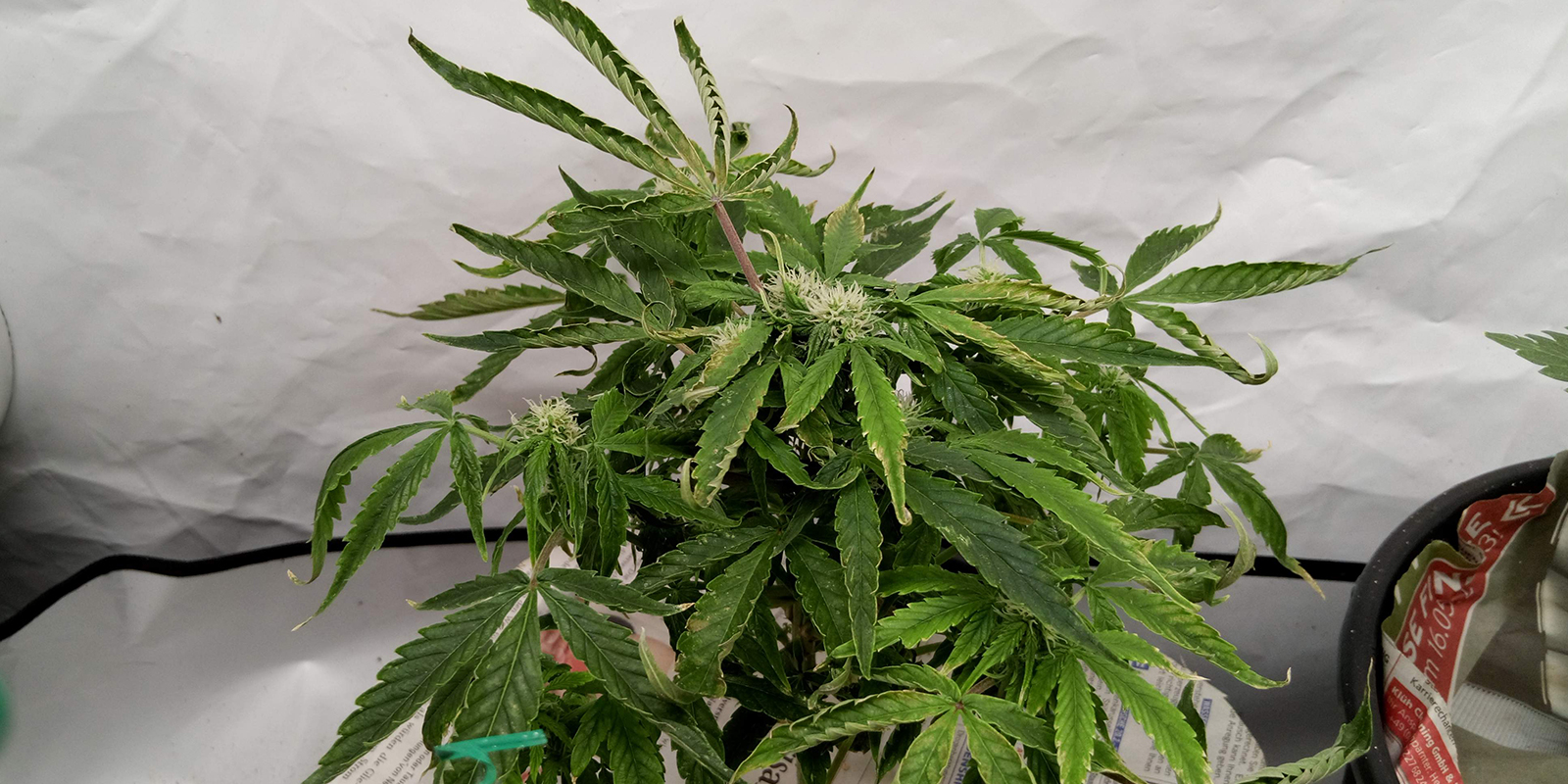
Next, take a step back and look at where the curling occurs. Top leaves curling upward usually point to light or heat stress, while lower leaves curling up often suggest watering or root problems.
Check multiple parts of the plant, not just one or two leaves, to identify consistent patterns. Uneven curling or damage on one side may reveal issues with airflow or uneven light exposure. This careful observation is crucial for early diagnosis before damage spreads to new growth.
3. Make small, targeted adjustments
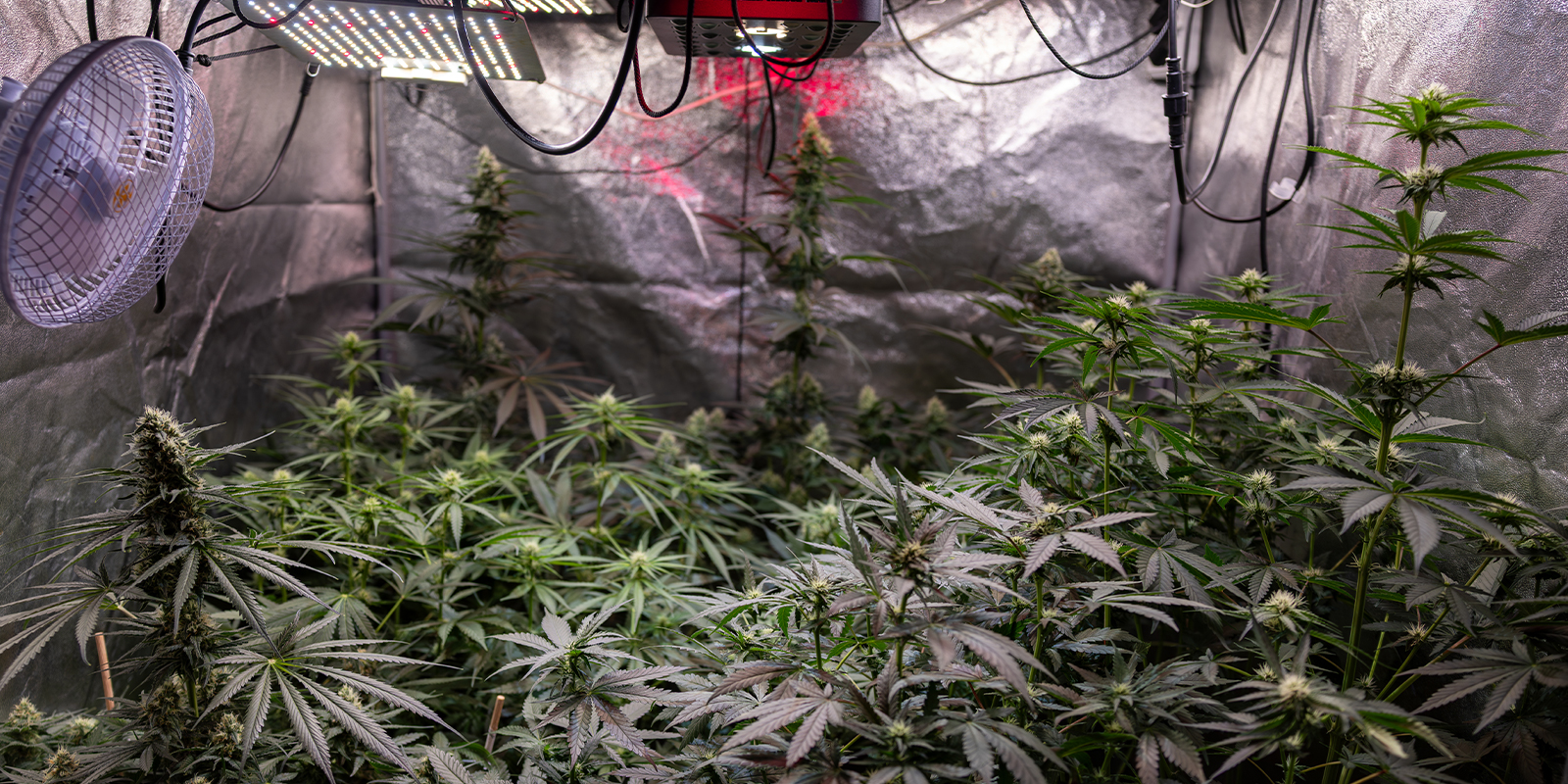
Once you've identified the likely cause, make controlled changes rather than drastic ones. Raise your lights slightly, adjust fan direction to prevent direct wind, or allow the growing medium to dry out before the next watering. Avoid heavy feeding or sudden environmental changes; leaf curling often improves within a few days of small, steady corrections.
By following these three simple steps: checking, observing, and adjusting, you'll not only fix cannabis leaves curling up but also prevent future stress from developing. Once you restore balance, most plants will recover their normal shape within a week.
When to be concerned
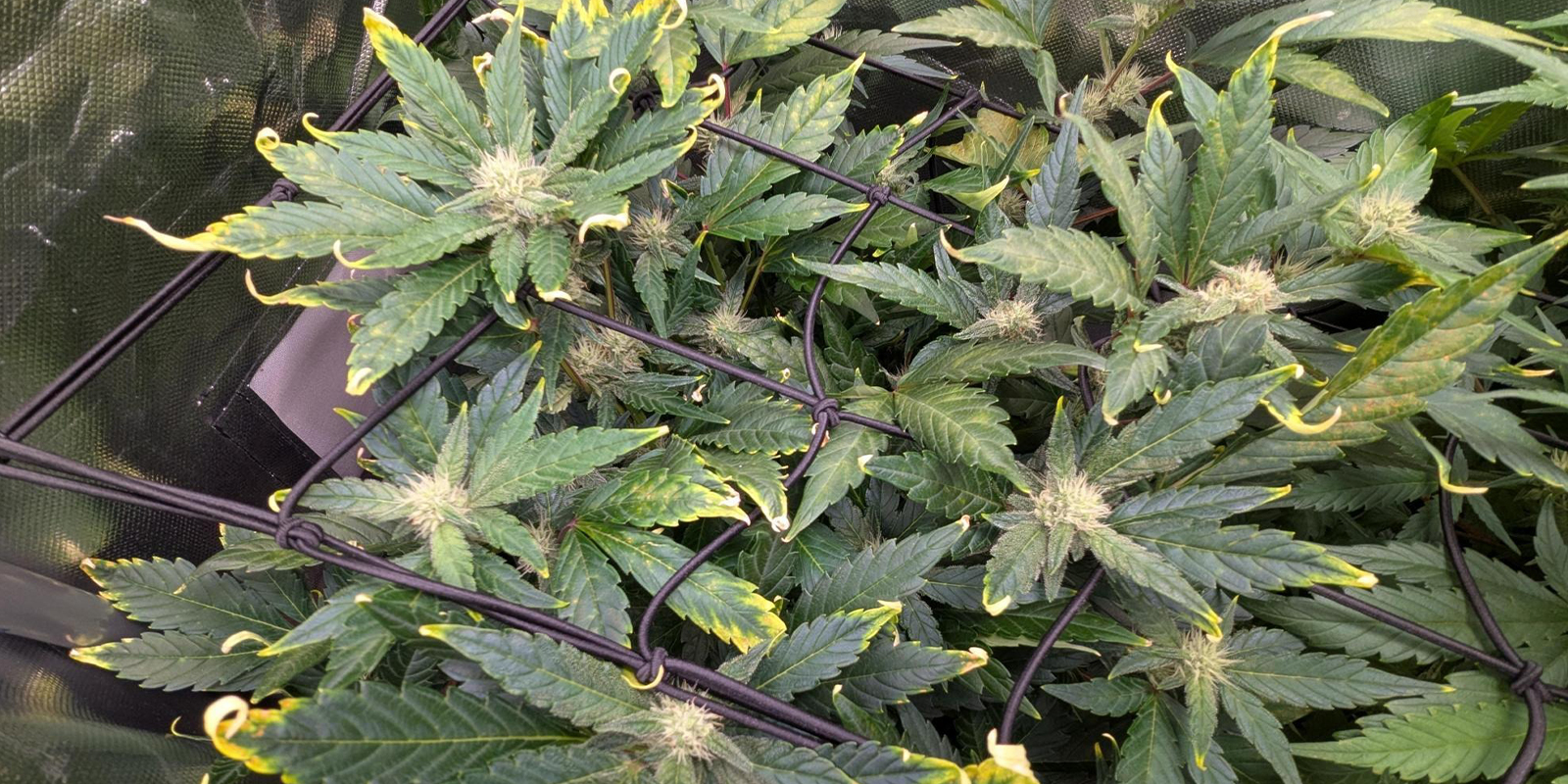
In most cases, cannabis leaves that curl up will flatten out again within a few days once you've corrected the underlying issue. However, if symptoms continue or worsen after making adjustments, it's time to look deeper.
Persistent cannabis leaf clawing may indicate more serious problems below the surface, such as root rot, mold or ongoing nutrient toxicity. If the leaves begin to turn dark, wilt or emit a musty smell, these are signs of root or microbial stress that simple environmental tweaks won't fix.
Also, pay attention to how quickly symptoms spread. When multiple plants begin showing cannabis leaf curling up despite stable conditions, contamination or systemic imbalance could be the cause. Checking root health and substrate quality can help you catch these issues early.
Remember: upward curling is your plant's cry for help, not an automatic death sentence. With quick attention and steady observation, you can restore balance and get your cannabis leaves reaching for the light again.
Leaves curling up? Time to straighten things out
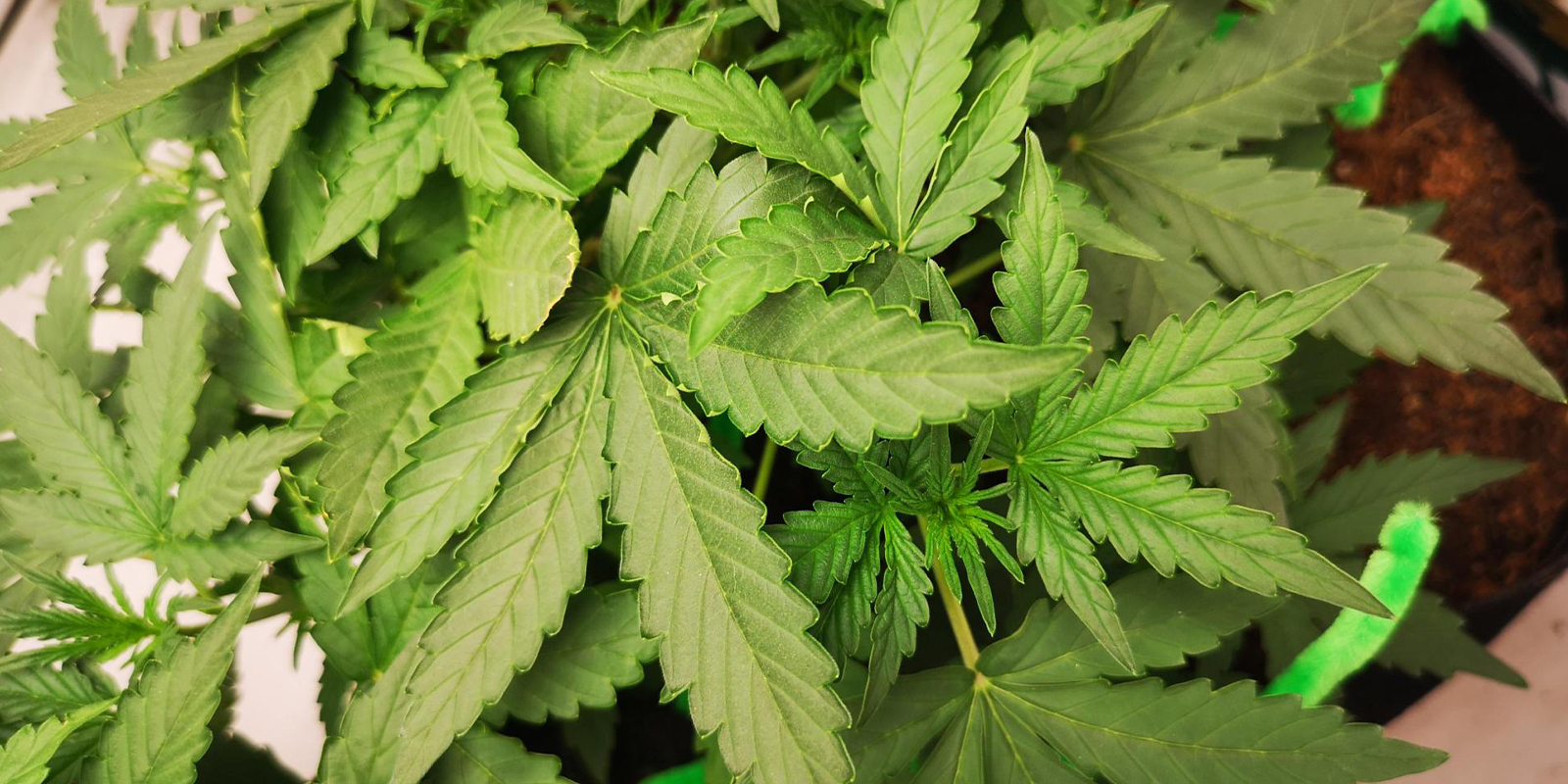
There's no denying it: seeing your cannabis leaves curling up might seem alarming, but as you've seen, it's usually a simple case of environmental or nutrient stress, and best of all, entirely fixable. Once you've balanced your light, temperature, humidity and watering routine, those clawing cannabis leaves will soon relax and flatten out again.
If your plants ever show the opposite problem: leaves curling downward or drooping, check out our companion guide: fixing downward curling of cannabis leaves. It explains how to diagnose overwatering, nutrient lockout and other issues that cause leaves to curl the other way (downwards).
For even more expert tips on growing healthy, resilient plants, explore our full range of cannabis growing guides. With the proper knowledge, you'll be ready to handle any leaf curl, claw, or twist your plant throws at you, and keep your garden thriving from seed to harvest and beyond.





 United States
United States










